|
Cruising the Canals
of France
by Scott
Porter (photos by
Sue Porter)
We would like to thank Scott Porter for
this insightful and informative article about his very recent canal
cruising experience in France
and to Sue Porter for
the great photographs to illustrate their adventure. The Porters
have sailed on France's canals before, and Scott
is an avid sailor along the Pacific coast. He is currently
a volunteer docent at the Maritime Museum of San Diego which has
one of the world's finest collections of historic ships and is ranked
the Best Maritime Museum in the United States.
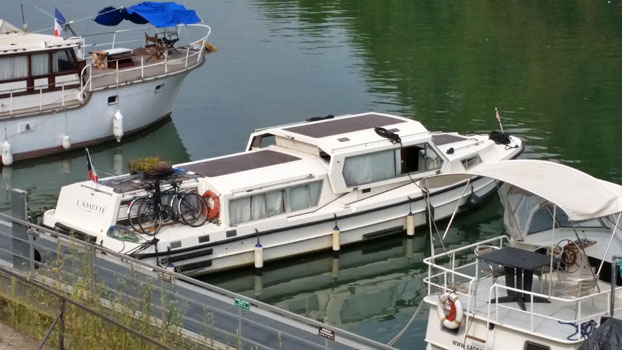
L'Amitié
We
got off the train in Chalon-sur-Saône,
south of Dijon, and took a
taxi to Porte
de Plaisance on the river. A large
fête
with music and dancing was going on in the cobblestoned plaza. Skirting
the
crowd with our roll-aboards rattling across the stones, we worked our
way over
to the wall overlooking the River Saône from the east bank. The town was an important crossroads for trade since the
Middle Ages and is at the northern edge of the Saône Valley where
the Burgundy wine route travels south to Macon. Looking
to our right upstream, the river
appears from behind the trees, taking a broad curve to its right to
flow across
our tableau and to our left where it hooks up with the Rhône at
Lyon to travel south on its journey to the Mediterranean.
I wondered what exactly was
around
that corner, up river. Jim and Myrna waved up to us from the dock
below, and we rolled the bags down the cobblestone ramp to climb aboard
L'Amitié
(Friendship). Following a pleasant lunch, Jim fired up the engine
and
we cast off, slowly motoring up river. Around the curve, we
turned into the Canal du Centre which climbs over the hills and
connects to the Saône River to the River Loire on its way north
to
Orléans. We would go up the canal as far as Chagny.
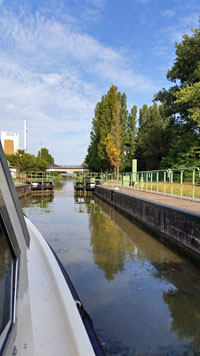
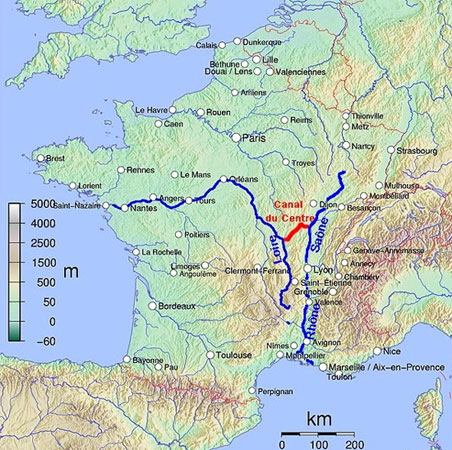 We have known Jim and
Myrna since the early 1980s in San Diego. He has had a number of
sailboats and was an avid racer up and down the Southern California
coastline for may years. Myrna learned sailing on a charter from
Fiji to New Zealand, directly into the teeth of the Roaring 40s (strong
westerly winds found in the Southern hemisphere). We have known Jim and
Myrna since the early 1980s in San Diego. He has had a number of
sailboats and was an avid racer up and down the Southern California
coastline for may years. Myrna learned sailing on a charter from
Fiji to New Zealand, directly into the teeth of the Roaring 40s (strong
westerly winds found in the Southern hemisphere).
But, as we are all moving into our 70s, they decided motoring
casually along a waterway on a flat deck, sliding past views of the
French landscape and estates with vast lawns rolling down to the
water's edge or cottages alongside the canals, profuse with bright
flower
boxes, is a more civilized way to pass the days in our later
years. And, we heartily agreed.
The history of the
French canal system goes back to the 1600s as a method of cheaply and
safely transporting goods along the eastern half of the country as well
as east into Switzerland and Germany. Oxen hauled the barges
along the towpaths on each bank of the canal. The largest
collection of canals is based along the Rhône and Saône
rivers, east of Paris, as well as all the way down to the
Mediterranean. When the railroads took over, the canals
languished until the early 1990s when the British, with much experience
in their own country, began exploring the options in France. As a
result, the French canals experienced a renaissance, attracting boaters
from all over the world. In the seven days we were there, we met
people from England, Ireland, Switzerland, Germany, Latvia and New
Zealand, plus a fair amount of French, of course.
Our first canal
boat experience had been with Jim and Myrna on the Canal du Midi, built
to transport wheat, wine and textiles from Nîmes. It
connects the Mediterranean heading northwest, below the walled city of
Carcassonne, on through Toulouse and up the Garonne River to Bordeaux
and into the Atlantic, and east through the Etang du Thau to the
Mediterranean.
Since then, the
plane trees along the Canal du Midi (which provided a supporting root
system for the banks, plus a leafy canopy overhead) have been attacked
by an awful blight requiring many to be cut down. And so, Jim and
Myrna moved their boat up the Rhône and on to the Saône
River with access to the vast French canal system.
And so, we were
motoring around the bend in the river. On most mornings, we would
walk or bike into a nearby village in search of a boulangerie.
Loading up with croissants, pain au
chocolat and a baguette, of course, we pedaled back to the boat
where café presse and jus d'orange awaited. The
most enjoyable part of this experience and what kept us coming back
was the opportunity to interact one to one with the locals in the small
villages. Following a pleasant repast, we would fire up the motor
and head around the next bend ~ looking for the next lock.
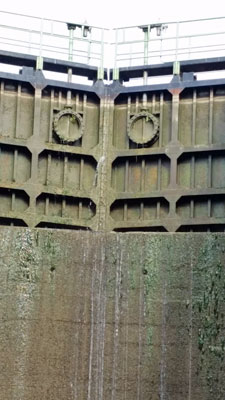 We finally reached Chagny which is
most famous for its Michelin 3-star restaurant,
Maison Lameloise. We then reversed course to head back
down the canal to the Saône to turn north to Verdun-sur-la-Doubs
which lies at the confluence of the Saône, Doubs and Dheune
rivers and is considered a fisherman's paradise. It is also home
to a fine museum, Musée
de la Maison du Blé et du Pain. Our final stop was
Auxonne, a commune with a strong military history whose arsenal was
designed and built by Vauban. It also has the distinction of
being home to the Artillery School where Napoléon had his first
training. We finally reached Chagny which is
most famous for its Michelin 3-star restaurant,
Maison Lameloise. We then reversed course to head back
down the canal to the Saône to turn north to Verdun-sur-la-Doubs
which lies at the confluence of the Saône, Doubs and Dheune
rivers and is considered a fisherman's paradise. It is also home
to a fine museum, Musée
de la Maison du Blé et du Pain. Our final stop was
Auxonne, a commune with a strong military history whose arsenal was
designed and built by Vauban. It also has the distinction of
being home to the Artillery School where Napoléon had his first
training.
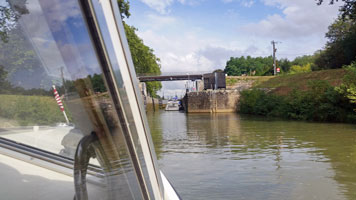 Passing
through the locks is an interesting experience; the locks on the canal
are
different than locks on the river, but are quite necessary when the
terrain
becomes hilly. Typically, the water source
for the canals is flowing down from the surrounding hills.
Each lock has an upper and lower gate, and each gate
has two side-hinged panels which
open in the downhill direction. A lock
can usually accommodate four to six boats, depending on their lengths,
but no
more than two abreast so that each can wrap lines around bollards set
into the
canal wall and which will float along with water level.
Bollards are posts with a horizontal rod
about 10-12 inches from the top so the line won't slip off and you are
less
likely to be banging into other boats or the lock walls. Passing
through the locks is an interesting experience; the locks on the canal
are
different than locks on the river, but are quite necessary when the
terrain
becomes hilly. Typically, the water source
for the canals is flowing down from the surrounding hills.
Each lock has an upper and lower gate, and each gate
has two side-hinged panels which
open in the downhill direction. A lock
can usually accommodate four to six boats, depending on their lengths,
but no
more than two abreast so that each can wrap lines around bollards set
into the
canal wall and which will float along with water level.
Bollards are posts with a horizontal rod
about 10-12 inches from the top so the line won't slip off and you are
less
likely to be banging into other boats or the lock walls.
Once inside, the
gates close behind you and you are in the 'Toilet Bowl Zone'.
Locks can be as high as 30+ feet and the water fills and drains very
quickly. Down locking is more civilized since the water is
draining, but up locking is much more turbulent. Water is
flooding through pipes near the bottom causing a surge pushing you
back. Then, it surges forward as it rebounds off the back
gate. Hold onto your lines. It is not overwhelming ~ just a
new experience.
Myrna shared that
the canal bank makes a great place to tie up either for a brief rest or
overnight, plus it gives an opportunity to meet fellow boaters.
"It's always a treat to watch Jim converse with a Frenchman about
boats, neither speaking the other's language but somehow understanding
each other," she tell us. Piquets (spikes) are used to secure the
boat to the bank. The balloon fenders hanging off the sides to
prevent hull damage in the locks create a slightly wider gap when
stepping ashore; it is good to have an agile crew member aboard.
There are many boat rental companies available in various
locations. Saône
Bateaux has a very nice web site which explains a lot of the
details and shows a variety of choices. Some of their boats have
bow and stern side-thrusters which make the entire tie-up process very
civilized. Most boats have at least two staterooms, each with its
own toilet and shower facilities. Something in the 35-40 foot
range should be quite comfortable and manageable. There are also
some companies that offer longer, thinner boats (péniches) which
come with a crew and chef if you prefer a smaller 'cruise ship'
experience.
If you would like
to read more about chartering, I recommend A Practical Guide for
European Canal Boat Charters by Heather C. Thomas (2014).
It
covers a lot of issues and has answers about many matters that you may
not have anticipated. I found it to be comprehensive and
understandable for all levels of experience. The e-book is
available on Kindle for $6.99 and free for Kindle
Unlimited.
Or, if you would
just like to settle in for an armchair ride with droll English humor, I
would suggest Narrow Dog to
Carcassonne: Two Foolish People, One Odd
Dog, and English Canal Boat . . . And the Adventure of a Lifetime by
Terry Darlington (2008). Kindle $13.99.
Safe travels, and bon voyage.
If you would like to read more about
cruising the canals of France on a péniche (converted Belgian,
Dutch or French river cargo
barge)
with a crew and chef, click here
to read one of our past newsletters. The particular
péniche referenced in our article is no longer
in
the canal cruise business, but there are many others from which to
choose.
[Map courtesy
of Wikipedia.]

|
|


 previous
page
next page
previous
page
next page 